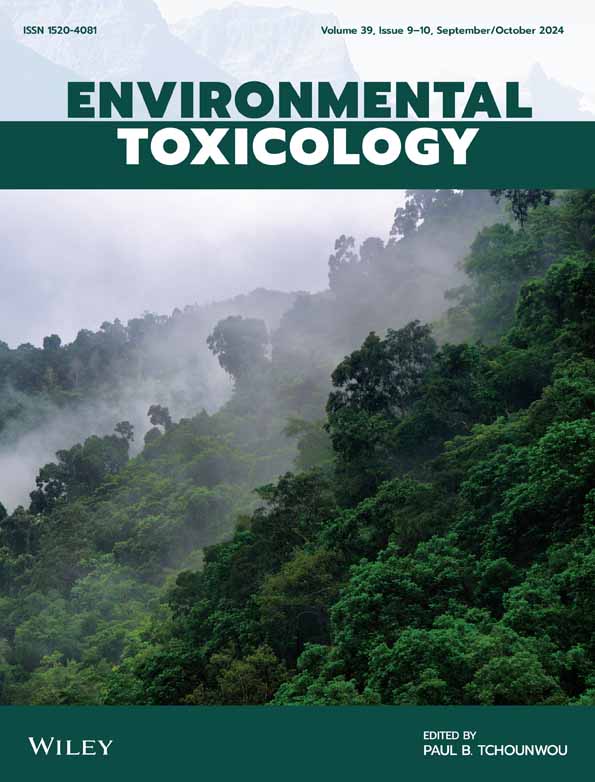静脉注射齐墩果酸脂质体可改善空气污染物引起的肺损伤
IF 3.2
3区 医学
Q2 ENVIRONMENTAL SCIENCES
引用次数: 0
摘要
空气污染物(如细颗粒物)造成的健康问题在世界范围内日益普遍,迫切需要制定预防和治疗战略,以遏制这种增加。空气污染物引起健康问题的主要机制是通过进入呼吸系统并增加氧化应激。齐墩果酸(OA)是一种天然的五环三萜化合物,存在于多种植物中,具有多种生理作用,包括抗氧化、抗癌和抗炎作用。然而,OA对空气污染物所致肺损伤的影响尚未见报道。因此,我们使用颗粒物质(PM)诱导的肺损伤小鼠模型分析OA的作用。雄性ICR小鼠口服OA (5-80 mg/kg)可抑制PM诱导的支气管肺泡灌洗液中炎症细胞计数、蛋白水平和dsDNA水平的增加;然而,效果并不显著。因此,我们分析了用聚乙二醇修饰脂质体(OA‐Lipo)包裹OA静脉给药的疗效。低剂量静脉给药OA - Lipo (20-100 μg/kg)比口服给药对PM诱导的肺损伤更有效。OA‐Lipo还显著抑制PM暴露小鼠炎症细胞因子和趋化因子的表达以及ROS的产生。此外,静脉给药OA‐Lipo增加了小鼠肺部各种抗氧化因子的表达。基于这些结果,我们认为OA‐Lipo通过增加各种抗氧化因子的表达来发挥抗氧化作用,从而防止空气污染物引起的肺损伤的发展。本文章由计算机程序翻译,如有差异,请以英文原文为准。
Intravenous Administration of Liposomes Encapsulating Oleanolic Acid Ameliorates Lung Injury Caused by Air Pollutants
Health problems caused by air pollutants, such as fine particulate matter, are becoming more prevalent worldwide, and there is an urgent need to develop prevention and treatment strategies to combat this increase. A main mechanism by which air pollutants cause health problems is by entering the respiratory system and increasing oxidative stress. Oleanolic acid (OA) is a natural pentacyclic triterpenoid compound found in various plants that exhibits many physiological effects, including antioxidant, anticancer, and anti‐inflammatory effects. However, the effect of OA on lung injury caused by air pollutants has not been reported. We therefore analyzed the effect of OA using a mouse model of particulate matter (PM)‐induced lung injury. Oral administration of OA (5–80 mg/kg) to male ICR mice suppressed PM‐induced increases in inflammatory cell counts, protein levels, and dsDNA levels in bronchoalveolar lavage fluid; however, the effects were not significant. We therefore analyzed the efficacy of intravenous administration using OA encapsulated in polyethylene glycol‐modified liposomes (OA‐Lipo). Intravenous administration of OA‐Lipo (20–100 μg/kg) was more effective against PM‐induced lung injury at lower doses than oral administration. OA‐Lipo also significantly suppressed increased expression of inflammatory cytokines and chemokines and ROS production in PM‐exposed mice. Furthermore, intravenous administration of OA‐Lipo increased the expression of various antioxidant factors in the lungs of mice. Based on these results, we believe that OA‐Lipo exerts an antioxidant effect by increasing the expression of various antioxidant factors, thereby preventing the development of lung injury caused by air pollutants.
求助全文
通过发布文献求助,成功后即可免费获取论文全文。
去求助
来源期刊

Environmental Toxicology
环境科学-毒理学
CiteScore
7.10
自引率
8.90%
发文量
261
审稿时长
4.5 months
期刊介绍:
The journal publishes in the areas of toxicity and toxicology of environmental pollutants in air, dust, sediment, soil and water, and natural toxins in the environment.Of particular interest are:
Toxic or biologically disruptive impacts of anthropogenic chemicals such as pharmaceuticals, industrial organics, agricultural chemicals, and by-products such as chlorinated compounds from water disinfection and waste incineration;
Natural toxins and their impacts;
Biotransformation and metabolism of toxigenic compounds, food chains for toxin accumulation or biodegradation;
Assays of toxicity, endocrine disruption, mutagenicity, carcinogenicity, ecosystem impact and health hazard;
Environmental and public health risk assessment, environmental guidelines, environmental policy for toxicants.
 求助内容:
求助内容: 应助结果提醒方式:
应助结果提醒方式:


